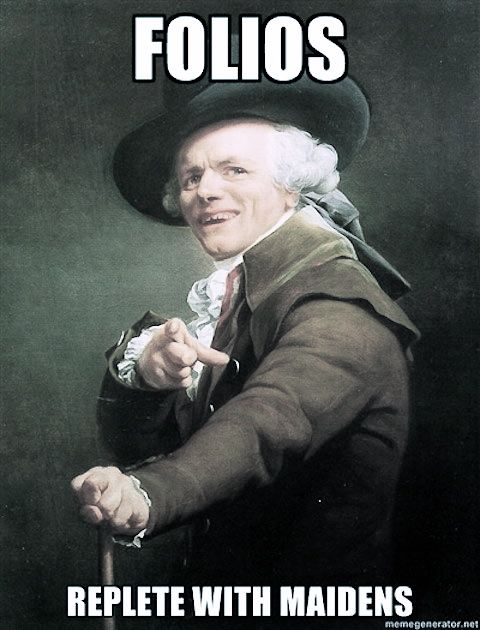Memes as Dissent
Participation is a strategic, embodied performance.
On October 20, 2012, presidential candidate Mitt Romney was asked about his stance on equal pay during a townhall-style presidential debate. I was watching the debate that night, and had a Twitter stream up on my laptop, while chatting with friends on Facebook. As I recall, Romney rambled defensively in his response, attempting to defend his record as governor. He claimed that he tried very hard to find qualified women for his cabinet and in fact he had "binders full of women." Seconds later, Twitter and Facebook exploded with negative commentary. Within minutes, memes began to circulate, recasting the words "binders full of women." The Joseph Ducreux meme is just one example (fig. 5). In the original image, Ducreux, hat slightly askew, smiles charmingly and points at the viewer. The meme adds an ironic caption to the portrait: “Folios replete with maidens.”

Reactions to the “binders full of women” meme exulted in the immediacy of satiric dissent made possible through technology. In cyberspace as in the classroom Critel describes, the topoi of technology have direct effects on participation. However, as Critel notes, participation "is constructed with a social code that constructs it as face-to-face and embodied" (183). Technology as topoi complicates that code. As Critel points out, the writer/composer remains in their body. The composing work necessary to the student in the computer-mediated classroom as well as the meme creator in their living room with a laptop remain classed, gendered, and raced, despite the apparent disembodiment of the compositions they create that spin out across networks. The mark of participation becomes writing consistently and well, whether in order to gain the right grade or to gain the social capital possible if your meme gets picked up and recirculated.
It's easy to make a meme these days. Meme Maker, for example, is typical of the dozens of applications available on the Web, image supplied, just add text. Richard Dawkins developed the term in his 1976 book The Selfish Gene in order to explain how ideas and knowledge get transmitted and circulated (ctd. in Knobel and Lankshear 200-01). The Internet, a native space for the rapid emergence and circulation of cultural objects, instantiates and redefines the term. Here, as Knobel and Lankshear point out in their essay "Online Memes, Affinities, and Cultural Production," memes can be typed and analyzed according to Dawkins's meme descriptors fidelity, fecundity, and longevity (200-02). While the Binders Full of Women meme did not last long, the meme was remarkably fecund, drawing participation across broad swathes of social media as well as appearing in newspapers, magazines and other news media during the last months of the presidential campaign. Arguably, this meme instantiates Critel's notion of participation as "strategic, embodied performance" (186). Without the distance of aura, with the ease of a few clicks, viewers angered by Romney's reference to women could respond, and others with smartphones or tablets or computers at hand could grab up and retweet or repost and send on waves and waves of memes. In effect, this moment represents the beginning of an emergent participatory economy in which meme makers compose cultural objects, set them into the fast eddies of Internet circulation, and watch them go, instigating the production of more and more cultural objects.
Moreover, dissent may begin here: to express distaste or anger against a candidate's position and to be able to participate within a broad-based community to do so suggests a start. Participants may intuit an action to be taken. However, retweeting only gestures to embodied dissent.
Memes characteristically emerge fast and circulate at a rapidly increasing pace until a tipping point (a topic worth some study) when they diminish and dwindle. They exist because of participation and could not exist without twenty-first-century technology. Well-known participatory memes such as Numa Numa, Star Wars Kid, the Lolcat, Sad Keanu and Joseph Ducreux's Portrait as in the header image above, while remarkably fecund, do not in themselves represent embodied participation as dissent. However, a subset of memes do. I consider examples of these memes in the following two sections.
[Go to "'Don't Tase Me, Bro'"]